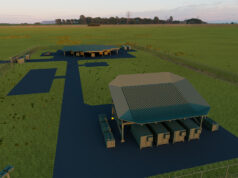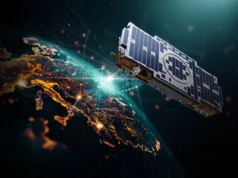NASA and Lockheed Martin have finalised a contract for the production and operations of six Orion spacecraft missions and the ability to order up to 12 in total.
Orion is NASA’s deep space exploration spaceship that will carry astronauts from Earth to the Moon and bring them safely home. Lockheed Martin has been the prime contractor during the development phase of the Orion program.
“This contract clearly shows NASA’s commitment not only to Orion, but also to Artemis and its bold goal of sending humans to the Moon in the next five years,” said Rick Ambrose, executive vice president of Lockheed Martin Space.
“We are equally committed to Orion and Artemis and producing these vehicles with a focus on cost, schedule and mission success.”
The agency’s Orion Production and Operations Contract (OPOC) is an indefinite-delivery, indefinite-quantity (IDIQ) contact for NASA to issue both cost-plus-incentive fee and firm-fixed-price orders. Initially, NASA has ordered three Orion spacecraft for Artemis missions III-V for $2.7 billion.
Then in fiscal year 2022, the agency plans to order three additional Orion spacecraft for Artemis missions VI-VIII for $1.9 billion, according to a release.
The first spacecraft delivered on this contract, Artemis III, will carry the first woman and the next man to the Moon in 2024, where they will dock with the Gateway and ultimately land on the surface using a lunar landing system.
“Orion is a critical part of the agency’s Artemis program to build a sustainable presence on the lunar surface and to prepare us to move on to Mars. Reusable Orion crew modules and systems, use of advanced manufacturing technologies, material and component bulk buys and an accelerated mission cadence all contribute to considerable cost reductions on these production vehicles.”
“We have learned a lot about how to design and manufacture a better Orion—such as designing for reusability, using augmented reality and additive manufacturing—and we’re applying this to this next series of vehicles. Driving down cost and manufacturing them more efficiently and faster will be key to making the Artemis program a success,” said Mike Hawes, Orion program manager for Lockheed Martin Space.
“One must also appreciate how unique Orion is. It’s a spaceship like none other. We’ve designed it to do things no other spacecraft can do, go to places no astronaut has been and take us into a new era of human deep space exploration.”
Lockheed Martin and NASA recently announced the completion of the Orion crew and service module being developed for the Artemis I mission, an uncrewed mission to the Moon. Work on the spacecraft for the Artemis II mission, the first crewed Orion flight to the Moon, is well underway at the Kennedy Space Center in Florida.











Wow… exciting times ahead. I think NASA is correct in that we need an enduring presence on the Moon to prove technology and concepts before a move onto Mars- the daunting and hard fact is that mankind has about 1.5-2 billion years to leave the solar system and colonise space before our sun expands and we as a species and the planet Earth are toasted. or before we get taken out by an asteroid (yes like the dinosaurs)
Orion is a step in the right direction but ultimately science needs to develop a safe, faster than light or near light speed propulsion systems to reach neighbouring star systems in a time-frame that is viable. Using current technology it would take manned flight or a colonisation flight decades/ lifetimes to reach our nearest near star system, which is only 4-12 light years away, depending upon which M class star we head for. These are star systems that we know have rocky worlds in the “goldilocks zone”, meaning potentially able to sustain life and have water or ice on its surface.
So Orion is great but the steps have to be Moon- enduring presence, Mars- colonisation, Europa – as a staging post and enduring presence (Jupiter’s moon- with Ice surface) then onto deep space.
1.5 to 2 billion years? What form will mankind take by then I wonder? It certainly will not be anything like we are today, assuming of course we are around at all. Look at what we were like ‘just’ 500,000 to 1m years ago. In a billion years time we will either be extinct (most likely) or have evolved into something very different.
I honestly do not think we need to worry about the sun expanding, we will be the cause of our own demise long before that happens. Plus all plant life will likely die within 600 million years as a result of radiation being too high and reducing the CO2 needed to support plant based life. That will then be the end of all animal life as the food chain will collapse.
Unless the tech is developed to stop the radiation and preserving Earth.
Given the technological advances since the 40s,a mere 70 years or so, what will be developed in even a hundred years never mind a million?
Also, what you see in the white world is far behind what’s in the Black, which emerges decades later.
There is always hope.
Of course, I was just taking the micky at the timescales mentioned. Who knows what tech will be available in future to fight the earth’s problems.
One thing is for sure though, half the posters on UKDJ will still think you are a girl called Danielle 🙂
Lol. Let them. I’m used to it.
Exciting times very definitely but, if he gets there, I find the stuff that Elon Musk (EM) is doing is far more exciting than the NASA stuff. EM just did his annual update on the SpaceX Super Heavy launcher and Starship crew/cargo stage earlier this week. There is a ton of stuff about the update on the web but here is one fairly randomly chosen writeup – https://techcrunch.com/2019/09/30/spacex-details-starship-and-super-heavy-in-new-website/
It’s a 2 stage system, Super-Heavy is the sea-level and lower atmosphere launch (first) stage and “Starship” is the second stage to get to orbit but also then have enough propellant to leave earth orbit and, due to the lower gravity of the Moon have enough propellant to land the whole damn thing on the Moon and take off again. For Mars the concept is similar, Starship uses onboard propellant to go there and back and land and take off but refuelling at least in Earth orbit is needed after takeoff (by another Starship configured as a tanker) to give it fuel to get to Mars and land. I’m not sure if a second refuelling is needed at/on Mars as well. Basically though everything is re-usable including the first stage. What leaves the launch pad lands back down on earth at some point or maybe stays on the Moon or Mars as habitat additions if/when we do get to serious colonisation.
And don’t confuse Starship with a typical command-module-like crew system in terms of scale. It has about the same amount of pressurised internal habitable space as an Aibus A380 and in cramped “colonist” configuration they’re talking about 100 passengers for a Mars trip.
He’s already done a short up and down test flight of a mini Starship and is hoping that the huge silver prototype that can be seen in all this week’s reports will do a full-scale test flight to 60,000 feet in the next couple of months and get to orbit next year! Musk does tend to be a bit optimistic with timescales but, even though not always on time, SpaceX does tend to achieve them. And with everything reusable if all goes to plan that silver monster will take off, climb to 60,000 feet, and then come back down and land all within the next 9 weeks or so.
Yes exactly I find SpaceX infinitely more exciting and at the pace they’re going SLS and Orion will be obsolete if starship goes according to plan, also amazing an looking spacecraft cannot wait to see it fly
Even the 200m starhopper flight test was a sight to see, I’ve never seen any other flight test like it
Oops. Very slow update of comments for some reason. I couldn’t see your reply when I asked if you’d seen it. Odd. Anyway, my link might be of interest to others.
Did you see the YouTube clip of the stubby little one flying a few weeks ago James? Only a 150 metre test flight on a cut down version using a single engine but still pretty cool so see it go up, move around a bit and come back down again. Seeing the full size one do that in hopefully only a few weeks time will be amazing.
Video is here in case you didn’t see it…
https://www.youtube.com/watch?v=RziLyL44mSM
I think starhopper (the little one) will form the basis for a lunar lander type craft separate from starship, but yes the video is well worth a watch. Amazing progress makes you wonder what boeing ULA etc are doing with the billions they receive as all their programs (SLS Orion starliner) have barely started engine or flight tests
I thought Starhopper was basically the bottom part of the proposed Starship so as to test the basics principles before testing the whole thing, though maybe I misread it. I do agree though that it on the surface (if that is the right term) what SpaceX is achieving makes the major players look decidedly last decade or more though I will withhold my full judgement fully till we see how things develop beyond the showman stage.
I think you’re right Spyinthesky. I wonder if James might be conflating this test-bed Musc vehicle with Jef Bezos’s Blue Origin lunar lander unveiled in May this year (https://spacenews.com/blue-origin-unveils-lunar-lander/). Given that they (Bezos & Musk) are both billionaires funding commercial space projects that announced stuff at about the same time any accidental association between the two is quite understandable.
As I understand it if/when Musk’s stuff gets real it’s the whole huge Starship second stage that lands and takes off – an all or nothing deal. Go big or go home, or in the case of people brave enough to make such journeys hopefully both!
The latest pictures of simulations of the ship in space reminds me of Fireball XL5 for those of us of a certain age. It certainly looks like a new age of space flight will be upon if it comes off. However Orion much of which is based on updated design theories and work going back to the 90s I believe (which is why it has so much of Apollo in it visually) will likely be a good and reliable low risk space vehicle needed to do much of the donkey work that NASA will be involved in in future years (hopefully). I suspect Musk has somewhat lost interest in that area so this will generally leave him to concentrate on the ‘glory’ stuff.
I agree it does sound fantastical what Musk does and all power to him (though less to his mad bigotry) however we have to remember that this very week he has been chastised for being years late on promises to NASA to service the International Space Station while some of his schemes appear decidedly questionable beyond theory and prototype form, including his plans for the Boring Company. I think the Jury is still out with Musk as to how much is style over substance.
2 billion years…. I wonder what will be going on at the Queen Vic by then?
I will just say that tentacles will be so much more appropriate for holding multiple glasses of beer for the round that you are paying for with the spare one.
Using current technology would take tens of thousands of years to reach our nearest star system and that’s assuming proxima centauri was in the right position in the sky when we left
81,000 years or so, it’d have to be some kind of generation ship concept that would possibly at some point be overtaken by more technologically advanced craft as time passed.
81,000 years? The ship would have fallen apart long before then. Blimey just think how weird the crew would be after 81,000 years of inter-breeding!
Engineering would be a huge challenge. I read something a while back that suggested 100 couples would be enough for the population to remain genetically diverse.
I can only assume you are not including anyone from the LGBT community, gender neutral, gender confused and whatever else is out there now in that 100. I’m sure there will be hurt feelings involved and a royal commission study needed that will take so long no one will ever leave the planet ?
Lets not worry about the Remainers, the Leavers will as ever be more forward looking.
Unless there’s some form of artificial womb etc too then yes, we’d need heterosexual couples I’m afraid, at least initially. The Royal commission wouldn’t even get past appointing members.
“We must close the mine shaft gap!”
Exactly which is why I mentioned above how it would have to be almost like a mini planet (or cylinder if AC Clarke is designing it) to even have a hope of a successful concept. In reality it would be centuries of advancement and an understanding of technology and likely discoveries in the realm of sub atomic theory simply not conceived today most like, before even the thought of such a plan would go beyond the padded cell. Perhaps if we ever communicate with another civilisation we can meet half way in a thousand years or so. though likely that would be like all the excitement of a first date with the inevitable disappointment when it comes to pass.
tl;dr – we don’t actually need to break the speed of light barrier or create generational starships to open up our immediate neighbouring stars for exploration and potential colonisation. Sadly none of this is likely to happen in my lifetime though.
I’m not convinced it would need to come to that (mini-planet sized generation ships) even without faster than light travel. The stake in the ground that Steve placed (off the back of James’s comment) of 81,000 years to Proxima Centauri using current technology is certainly valid and a reality check but at about 4.25 light years from earth if we could only develop a suitable energy source to maintain sustained acceleration/deceleration at an acceptable level for years on end, say 1g constant acceleration (which would also be handy for artificial gravity) for 2 years and you could probably do the Proxima Centauri run in less then 12 parsecs – sorry, nerdy little Starwars joke; I mean less than 10 years.
Looking at it initially from the incorrect Newtonian point of view at 1g constant acceleration an object could be accelerated to the speed of light in pretty much exactly 1 year. As mentioned that is of course totally invalid because as the object approaches the speed of light (c) its inertial mass increases, ultimately to infinity, and since the force required for any given acceleration is proportional to mass it means that as one gets closer to c more and more force, hence energy, would be required to maintain the 1g constant acceleration. The relativistic mass effects aren’t catastrophic however until one gets quite close to c, e.g. at 0.5c the mass of the spaceship would be 1.15 times what it was at zero velocity.
I can’t be bothered to do the precise calculations, the maths is more complex to compensate for constantly varying mass, but the calculations that follow are really quite pessimistic I think because I’m over-estimating the relativistic mass effects. Anyway, given adequate energy to maintain that sort of acceleration I can see a ship spending the first year accelerating to at least 0.5c then coasting for 8 years to cover 4 light years and then decelerating for the final year for a total trip time of 10 years. The extra 0.25 light year distance to Proxima Centauri is more than made up from the fact that during the 2 years of acceleration/deceleration the ship is still moving towards its destination and that cumulative distance would be more than 0.25 light years so the time would actually be a bit under 10 years. If we could find enough energy to keep the engines burning for 4 years and get to more like 0.8c we’d probably be looking at more like 5.5 years to get there. The ideal would be to get to the point where we can keep the acceleration on for the whole trip so that, apart from a brief turn manoeuvre at the midway point, the ship accelerates at 1g for half the journey then pitches 180 degrees nose-to-tail and then decelerates at 1g for the second half of the journey so that the passengers and crew have 1g gravity all the way and it also minimises journey time.
In determining living conditions if we could get the energy for a < 10 year trip my starting point would be Herman Melville's Moby Dick! One thing that amazed me on reading that rather long book with lots of very detailed description that was apparently very well researched from the author's own experiences was that those old whaling vessels stayed at sea without touching land for literally years at a time and those were relatively small vessels with few creature comforts – no on-board video players, ebooks or games consoles (or at least they were never mentioned in the book). With a suitably selected crew (screened for emotional suitability) and suitably spacious but by no means mini-planet sized accommodations I suspect a 10 year voyage would be doable and a 5.5 year one more so.
And as a final kicker, not only does mass increase as velocity approaches c but also the people on the spacecraft will experience time running more slowly than observers on earth, earth being the frame of reference used for all the very approximate calculations above so those 10 year and 5.5 year journey times as measured from earth would actually be more like 8.7 years and 3.3 years as experienced by the astronauts. If we could only find the energy source(s) to keep up 1g acceleration for years on end the trip becomes far less daunting and current physics even has some candidates that might get us that energy e.g. fusion power seemingly almost within our grasp for a few decades now and way more speculative but way more exciting would be to harness zero-point energy (if it exists at the levels some hope).
Excellent post here Julian. Struck right at my admittedly nerdy heart.
My head hurts! Assuming we find technologies that make it possible to travel to the nearest star system in a few years, it would still require a crew (assuming we send people) to be away for 5 years (ish) and leave with the almost certain knowledge they are unlikely to return. Balls of steel required. Where’s Bruce Willis and his crew when you need them?
In that case there would be lots of time for the reruns of Eastenders.
I will be interested to see how we re engineer the Laws of Physics over the faster than light propulsion beyond Star Trek or indeed even the near light speed technology that is the minimum required as animal kind would be crushed well before the speed of Light was achieved under those laws as we currently know them. Not impossible perhaps that some form of Improbability Drive might be developed as we delve into the unknown of sub atomic theory but there is no evidence that will lead to a workable process that keeps humans alive (whatever we could achieve with single atoms eventually) even if we could control Black holes which is the only theoretical process I have seen suggested, so such possibilities to travel to let alone beyond perhaps the very closest of stars through a multi generational space ship seems totally speculative at best. And sadly none of the closest stars seem to be very promising while even those, which further away do contain such planets in the Goldilocks region would in reality overwhelmingly be likely to have planets that would not be habitable for us without at the very least terraforming on a scale of equally speculative practicality even if we could develop and get such technology there. Which is the reason that as far as we know we have not been visited by alien space craft or as yet even been able to establish signs of life beyond our planet.
I suspect the only practical method would not only be that multi generation ship I mention above but one that is almost on a scale to mimic most of the processes of our own planet though inside out containing all the assets of life, industry, nature and technology but no need for the Sun, that could travel and continually be repaired, re worked and upgraded over many centuries of travel while maintaining an environment inside that would give a sustainable and agreeable lifestyle without time limit to those inside over potentially hundreds of generations..
Whilst there are theoretical possibilities to FTL travel, Einstein Rosen Bridge’s and indeed Warp bubbles, the energy requirements in both and size of the former currently mean they will remain theoretical. There is scope to develop more efficient sources of power but again, we just aren’t there. Billions needs pumping into fusion for example before it becomes economical but the will doesn’t seem to be there.
Black holes are an interesting prospect if you’re looking to slingshot your craft to relativistic speeds (assuming you have engineered a craft to withstand such forces). It would be similar to current slingshot manoeuvers but scaled up by huge factors of 10. The interesting part is time dilation where the craft would be moving so fast that time would pass slower than for people back on Earth.
Habitable planets are indeed at this moment in time an issue. We just don’t have any suitable candidates, although one was discovered recently that has potential, albeit too massive in my opinion. The key is to look for replenishing Oxygen in the atmosphere which indicates something producing it, ie plant life. We have only detected around 4000 exoplanets so far, there are trillions more out there.
See my fairly long post above. If we could just crack the energy issue to the stage of keeping 1g acceleration for years on end I think that quite a few stars could be within our realistic reach. If it’s taking us 12 years to build Crossrail a 10 year journey doesn’t sound so bad. Sadly we do also need to factor in the time for the “We’ve arrived” message to get back to earth but eve so I think man can take the next step without needing to wait for FTL travel.
I agree. We just need to change our mindset from the short term parliamentary 5 year scale to one encompassing decades.
What would happen if one of those generation ships fronted up into our solar system?
Given the likelyhood of getting advance warning of us, via receiving all the tv and radio channels we have been eminating into outer space, then my guess is their reception from Eastenders and the One Show would have turned their ship round the other way pronto.
According to most science fiction novels that I’ve read featuring generational spaceships the occupants will have long since forgotten their history and will no longer realise that they are even on a space ship. The bridge and control rooms will somehow have become forgotten and inaccessible too so they also won’t have knowledge of or access to any of the technology on board except for benefiting from the automated life support systems keeping them alive.
I used to really enjoy stories about generational spaceships.
Yes. The other type of course is where the occupants are in hibernation. Back in the days when Dr Who produced decent stories they did both sorts.
But stay clear of the ships where the inhabitants have all taken to cannibalism. I don’t remember Doctor Who covering that one 🙂
I agree on the decent stories. I liked the fact that a story would unfold over 6 episodes rather than the “all over and resolved in 60 minutes” stuff churned out now. It was usually totally mysterious what was going on in at least the entire first if not first two episodes. By about episode 3 I was usually used to the monsters and could watch the last few episodes from on the sofa rather than from behind it.
Good timing as we will need these to ensure the 70 million people in this country are transported to the moon when Brexit happens…..what? Shit? You mean we are only leaving a trading block of nations and not moving lock stock and barrel to the moon without air, food, water, med supplies and sky sports? Damn that’s not what the remainers have been saying to anyone who would listen! Damn do you think they are possibly gilding the lilley and scaring people somewhat?
Woah nobody mentioned sky sports! 🙂
Its 1969 all over again.